AMPOWER, a consulting firm from Hamburg, Germany, released its annual market report on 2023 Industrial Additive Manufacturing in March 2023. Divided into two versions, Metal 3D Printing and Polymer 3D Printing, the report analyzes global industry developments in 2022 and provides an outlook for the next five years.
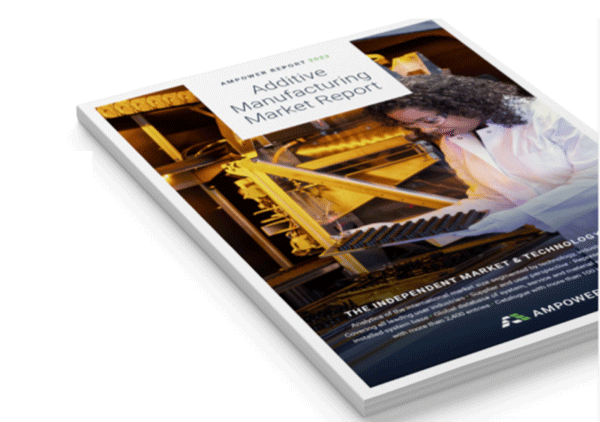
▲ Annual Additive Manufacturing Global Market Report © AMPOWER 2023
Global Market
According to the overall global industrial additive manufacturing market, including metal and polymer 3D printing devices, materials, and part manufacturing services, it is worth €9.53 billion in 2022 and is expected to grow at a compound annual growth rate (CAGR) of 17.7% through 2027. The industrial metal additive manufacturing market grew by more than 20% in 2022, narrowing the revenue gap with polymer 3D printing, however, the polymer AM additive manufacturing market accounts for approximately 70% of the total, and is therefore approximately twice the size of the metal additive manufacturing market. Looking ahead, the metal market is expected to grow more than twice as fast as the polymer market by 2027, further narrowing the gap with polymer additive manufacturing.
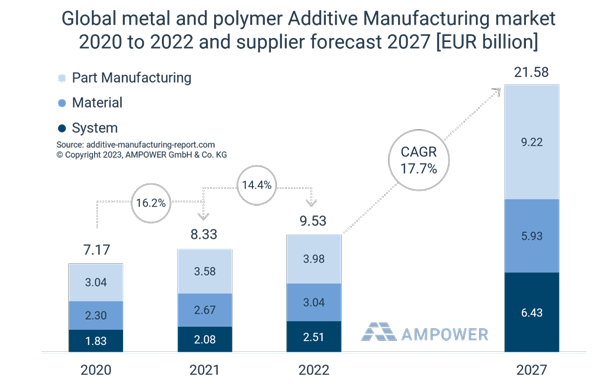
▲ Global Additive Manufacturing Market for Metals and Polymers (2020-2022, Forecast 2027) © AMPOWER
The metal additive manufacturing market is valued at €3.03 billion in 2022 and is expected to grow at a CAGR of 26.1% through 2027, while the polymer additive manufacturing market is expected to grow at a rate of 12.9% per year from €6.5 billion in 2022. Revenues from sales of metal and polymer 3D printing devices are roughly equal, however, polymer material and polymer part manufacturing suppliers generate much larger revenues due to the richer market and nature of polymer AM additive manufacturing applications.
Overall, the overall additive manufacturing market is projected to grow at an annual rate of 17.7%, according to 3D printing suppliers, and is thus expected to reach €21.58 billion by 2027. 3D printing equipment suppliers have had a successful year in 2022, with average revenue growth of more than 20%, and are optimistic about the coming years. By 2027, equipment suppliers expect the market to continue to grow at more than 20%.
Additive manufacturing equipment suppliers sold €2.51 billion worth of equipment in 2022, with one-third of the revenue from 3D printing equipment sales generated in the U.S. The world's dominant market for additive manufacturing products and services is the U.S. In 2022, revenue from metal and polymer 3D printing equipment sales in the U.S. totaled more than €800 million, up nearly 20 percent year-over-year. This equates to a 33% global market share. China creates the second largest local market, with 17% of total global additive manufacturing revenue from device sales.
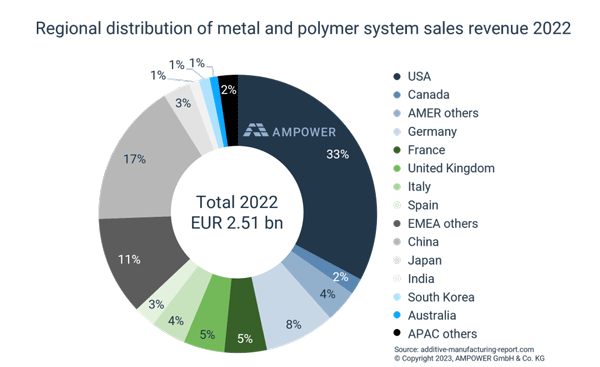
▲ Global Additive Manufacturing Market for Metals and Polymers (2020-2022, Forecast 2027) © AMPOWER
The medical industry remains a major application area for AM additive manufacturing equipment suppliers through 2022. Although the market share remains at around 11%, the overall market size increase leads to an increase in revenue of EUR 265 million in 2022.
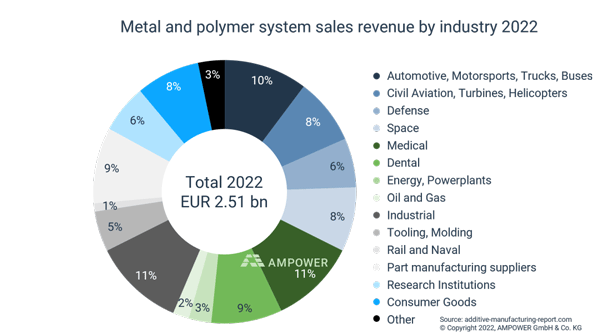
▲ 2022 Global Metal and Polymer Additive Manufacturing Market by Vertical Application © AMPOWER
PEEK material has the advantages of strong personalized matching, strong medical imaging compatibility, excellent mechanical properties, more convenient surgery, good thermal insulation, less post-operative complications, more suitable for such as cranial, rib repair fixation, sports medicine and other high strength requirements for the material, good stability. field.
▲ APIUM Bio PEEK 3D Printer Personalized Implant Solution
Overall, AM additive manufacturing devices are becoming larger and more complex. For example, Apium's next generation of 3D printers with FFF technology in 2022, the next generation of adaptive zone heating system provides excellent interlayer adhesion and greater strength and quality of printed parts. Users of polymer additive manufacturing also require a growing number of solutions. More print heads are appearing on the market for particle-based polymer 3D printing devices, such as those from Dutch startup CEAD, now pushing the size to up to 40 meters.
▲ APIUM P400 Dual Nozzle Adaptive Zone Heating System
In 2022, metal powder bed fused 3D printing devices accounted for 39% of overall 3D printing device sales revenue, a growth trend that continues and is expected to grow to account for 45% of device sales revenue in 2027, while another technology for metal 3D printing - binder jet metal 3D printing - is also maturing and is expected to account for 7% of device sales revenue in 2027. in 2022, the Polymer powder bed fusion 3D printing (PBF) systems account for 14% of equipment sales revenue.
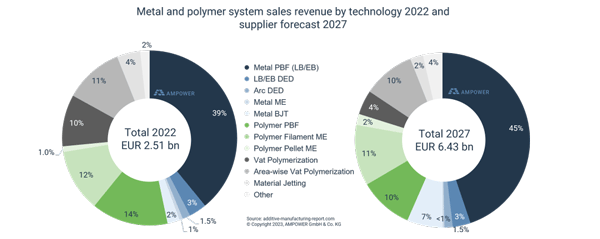
▲ 2022 Global Metal and Polymer Additive Manufacturing Market and Forecast 2027 by Technology © AMPOWER
However, it is becoming increasingly difficult for startups in 3D printing to attract funding in 2022. While many additive manufacturing companies have received significant funding over the past decade, startups are now encountering more cautious investors. In recent years, investors have tended to believe the overblown growth projections of additive manufacturing startups seeking funding. Some of these were able to make a significant impact and went public through SPAC deals after securing funding. However, the poor performance of post-IPO 3D printing companies is often the result of disappointment, as high expectations were not met.
AMPOWER believes that today's AM additive manufacturing investors are more rational and increasingly looking at long-term returns, which is more in line with the goals of the underlying investments. This benefits not only startups, but also the industry as a whole, as each other is looking for sustainable additive manufacturing solutions.
China Market
The obvious development in the 3D printing field in China in 2022 is the surge in orders from the aerospace and defense sectors, which subsequently corresponds to a rise in demand for metal powders, however, as price competition intensifies, the price of metal powders is also decreasing, corresponding to a sharp decrease in the price of 3D printed parts. However, against the background of fierce price competition, the main line of technological development is still born, and material-structure-performance integrated additive manufacturing has become a research hotspot for metal additive manufacturing.
In addition to the psychological factors associated with fringe political frictions, there are two main reasons that currently attract Chinese users to buy additive manufacturing machines from Chinese suppliers. One is the availability of customized process packages from local suppliers. These include process optimizations that take into account user-specific production elements, such as materials, component design, and equipment conditions. The result of these optimizations is better performance of the printed components. Another reason is that local suppliers can provide timely after-sales service for the local market. This shows that customers in China value the value that comes from localization and on-site after-sales service.
China is accelerating the creation of newer materials technologies, and the number of related patent applications in China will reach 3,079 in 2021, surpassing that of the United States. From the patent content, it can be seen that various types of composite materials, degradable materials and metal materials with better performance are the key directions of research and development at present. The stage breakthrough of the industry as a whole mainly relies on the commercialization development formed gradually under the policy support. For example, in the field of aerospace and military defense led by the state to gradually realize the renewal. Among them, the Additive Manufacturing Center of Xi'an Aerospace Engine Co., Ltd. has carried out the industrialization of additive manufacturing for the development needs of liquid power manufacturing and aerospace equipment, and introduced 89 sets of technologically advanced and complete types of additive manufacturing production equipment in two batches in 2022.
In recent years, the application of additive manufacturing has made significant progress in many industry fields, such as aerospace, automotive, medical, and mold, and has gradually expanded to personalized wear and other fields that are closely related to individuals. Compared with the huge application scenario of traditional manufacturing industry, the application scenario of additive manufacturing still has great potential to be tapped. In the future, as additive manufacturing is promoted in more fields and further popularized in various industry sectors, additive manufacturing will gain a broader incremental market.Gyrotec Technologies has a complete set of data analysis and personalized 3D printing solutions for medical, design, model, handicraft, industrial and other fields. Article source:3D Technology Valley.




























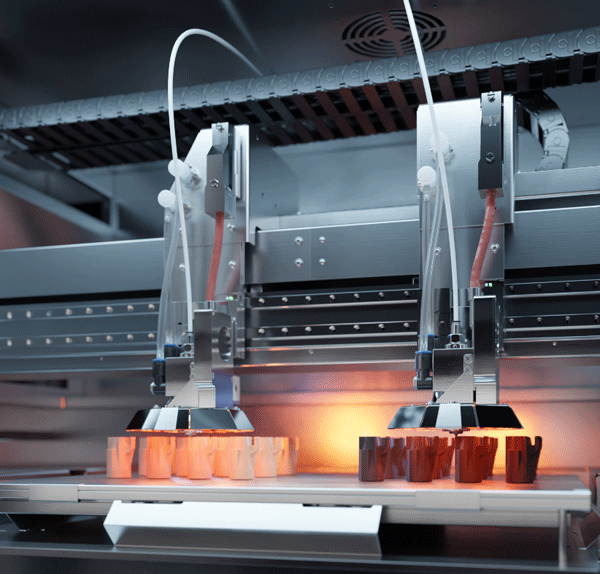
 Home
Home Telephone
Telephone Message
Message







